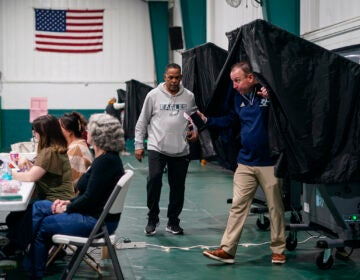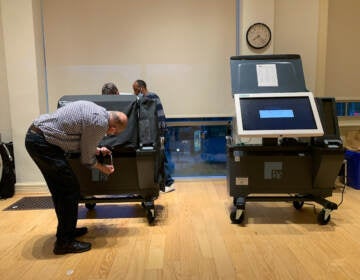Voting machines 2019: What to expect when you go to the polls Tuesday
Philadelphia, Chester and Montgomery Counties will have new voting machines on Election Day, while some other counties will be using older technology.
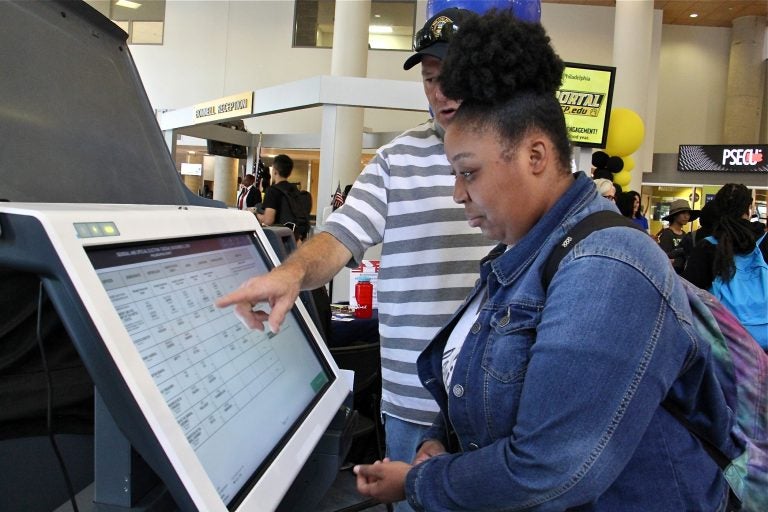
Community College of Philadelphia student Hanna Archibald, 20, learns how to use a new voting machine from Matthew McKeon of the City Commissioners Office. (Emma Lee/WHYY)
Election Day 2019 is upon us. That means it’s time to hit the polls Tuesday and cast your vote with what, in many counties, will be with swanky new voting machines.
Why new machines? A little background:
In 2018, following concerns over Russian meddling in the 2016 election, the Pennsylvania Department of State issued a directive requiring counties to upgrade their voting machines so that there would be a paper record of votes cast — and thus a verifiable paper trail.
So, wait, you might say: We’re voting with paper and pencil?
Not pencil, but in some cases, you will be voting with paper and pen. The answer depends on where you live, whether your county has upgraded its system yet, and — if it has — what type of machine it chose.
Some counties in the Philadelphia region have already made those upgrades. Others won’t be ready until next year. All Pennsylvania counties must select new voting machines by the end of this year and have them up and running by the state’s primary election in April 2020.
In total, the upgrade across the commonwealth will cost about $150 million. The state has proposed providing $90 million to help counties pay for new machines, though the Pennsylvania Economic Development Financing Authority’s board still has to approve the measure.
Here is a roundup of which voting machine to expect when you head to the polls Tuesday, depending on where you live.
Philadelphia County
This Election Day, Philadelphia is rolling out new voting machines for the first time in nearly 20 years. Demonstrations took place all across the city to prepare people for Tuesday’s election, and there are permanent displays of the new voting machines at City Hall and the Voter Registration Office at Delaware Avenue and Spring Garden Street.
In many ways, the new ES&S ExpressVote XL machine will be familiar. It involves a large touch screen, which voters will tap to make selections, and is protected by a privacy curtain, this one black while the old one was blue.
What’s different is how the machine is activated. When voters sign in, they will be given a blank paper ballot. They will take that blank ballot to an open machine and insert it into the machine, activating the touch screen. There will be two screens: one with the candidates for judicial and municipal races, and another with questions regarding judicial retention and any ballot questions.
Once you make your selections, you press a button that says “Print Ballot.” A printed paper ballot will appear behind a clear window next to the large touch screen, and the voter can review it to make sure that it accurately reflects the choices. The paper is behind glass and cannot be removed or touched by voters or poll workers.
After review, you press a “Vote” button to cast your ballot. If the paper ballot does not reflect the correct selections, you can cancel the vote and start over.
The city spent about $29 million on the contract for the new system, which involved the purchase of 3,750 machines, as well as other equipment including printers that won’t be used until the city transitions to electronic poll books. Only 3,500 machines will be used this election, with the other 250 being rolled out for the 2020 election.
Some, including City Controller Rebecca Rhynhart, have criticized the machine selection process, calling it opaque and unfair. Former Green Party presidential candidate Jill Stein has called the machines “hackable.”
City officials argue the machines are secure and Americans With Disabilities Act-compliant, allowing Philadelphia to buy just one kind of machine rather than two different systems.
Montgomery County
New voting machines made their debut in Montgomery County in the May primary, but there were a few hiccups.
The $5.7 million system, made by Dominion Voting Systems, involves filling in bubbles on a paper ballot — think elementary-school standardized test, only with a fine-tip Sharpie instead of a No. 2 pencil. The filled-out paper ballot is then fed into an electronic scanner, which records the votes. Those who are unable to use a pen and paper can use an ADA-compliant electronic ballot-marking device supplied by poll workers, which will also generate an approved paper ballot.
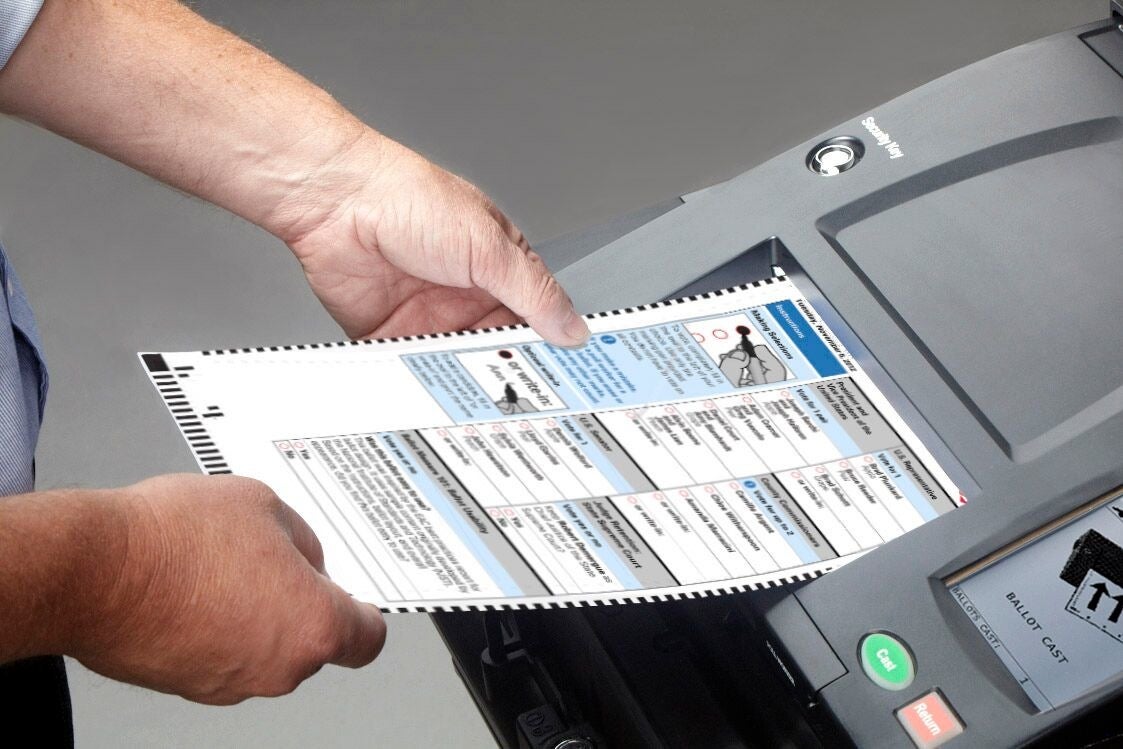
After the primary, the Montgomery County Board of Elections heard from more than 700 voters who had three main complaints: There wasn’t enough privacy; the lines were too long; and there wasn’t enough education for voters and poll workers.
Lee Soltysiak, chief operating officer and chief clerk for Montgomery County, said a lot of those kinks have been worked out.
For one, the alarm that went off during the primary when a voter abstained from voting in a certain race — something known as an undervote warning — has been turned off.
“Voters did not like the fact that anyone in the polling place would have any idea, frankly, the way in which they cast their vote,” Soltysiak said. “So going forward, that warning will be turned off.”
Voters will also be the only ones touching their ballots after signing in. During the primary, there were some reports of poll workers taking voters’ ballots from them and feeding them into the scanner.
“Every voter should scan their own ballot, unless they specifically request assistance from a poll worker,” Soltysiak said. “Under no circumstances should a poll worker be scanning a voter’s ballot unless they’ve been asked for assistance.”
Privacy will be enhanced by providing three to seven booths in which voters can fill out their ballots. Privacy booths will either take the form of individual standup booths with three sides or tabletop privacy screens, similar to upright open menus, that will allow people to sit at a table and fill out their ballots there.
Montgomery County has also increased the training of poll workers so that they are more familiar with the new system and understand how to interact with voters while maintaining privacy. A few precincts with larger turnout numbers will receive additional scanners so that a chokehold doesn’t form after people have filled out their ballots. Even more scanners are on order for 2020.
Some in the May primary complained of small type on the paper ballot forms. Soltysiak said magnifying glasses will be on hand for those who forget their reading glasses, and the ADA-compliant ballot marking device, which allows fonts to be made bigger, is available to anyone who prefers that option.
Soltysiak said the county wanted to work out the kinks now, well in advance of the 2020 presidential election.
“The driving reason we wanted to replace our system when we did, in part because of the age of the old system, truth be told, but we absolutely wanted to have two elections under our belt heading into what everyone expects will be a historic turnout in 2020,” he said.
Chester County
Chester County has been using paper ballots since 2006, so although it has new machines for 2019, they are merely upgrades of the ones voters have been using for more than a decade.
“Some [voters] may not even notice the difference,” said Sandy Burke, the county’s director of voter services.
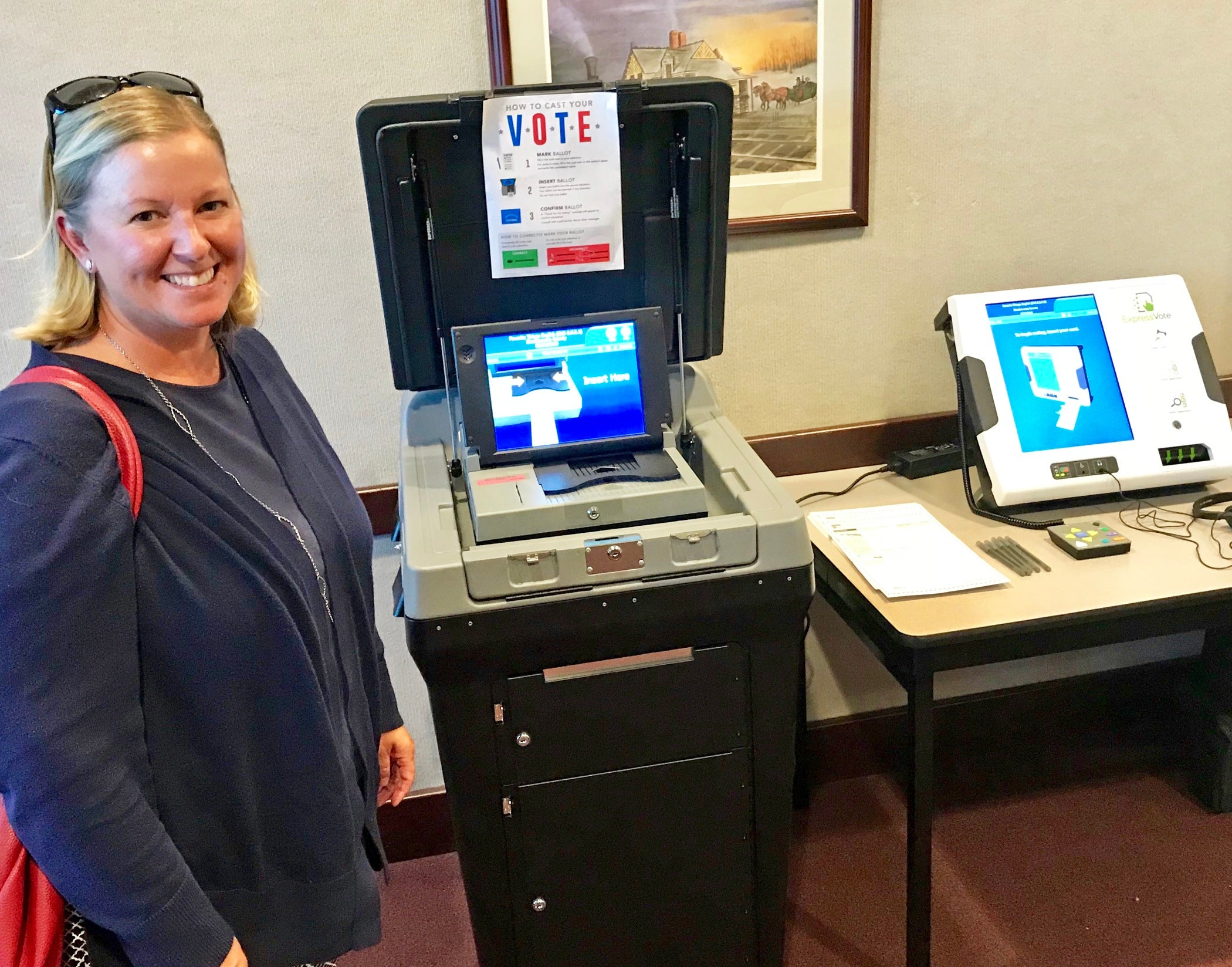
The digital scanner, the ES&S DS200, will be black instead of gray, but that is the only noticeable difference.
What is new this year is the ADA-accessible ballot marking device that will allow those needing accommodation to use an electronic device to generate a paper ballot, which will then be printed and fed into the scanner.
Otherwise, the process for the majority of voters will remain the same.
“We have the advantage of having worked with paper for the last 13 years,” Burke said. “So we don’t anticipate any sort of glitches or difficulties because our processes remain the same.”
The upgrade cost the county about $2.4 million.
Bucks County
Bucks will be using the machines it has used since 2006 — the Danaher Shouptronic 1242 — so when voters go to the polls, it will be same old, same old.
Of the five Philadelphia-area counties in Pennsylvania, Bucks is the only one that has not yet selected new voting machines that will leave a paper trail. Deanna Giorno, the county’s chief clerk, said county officials plan to make a decision by the end of the year and will roll out the new machines by the April 2020 deadline.
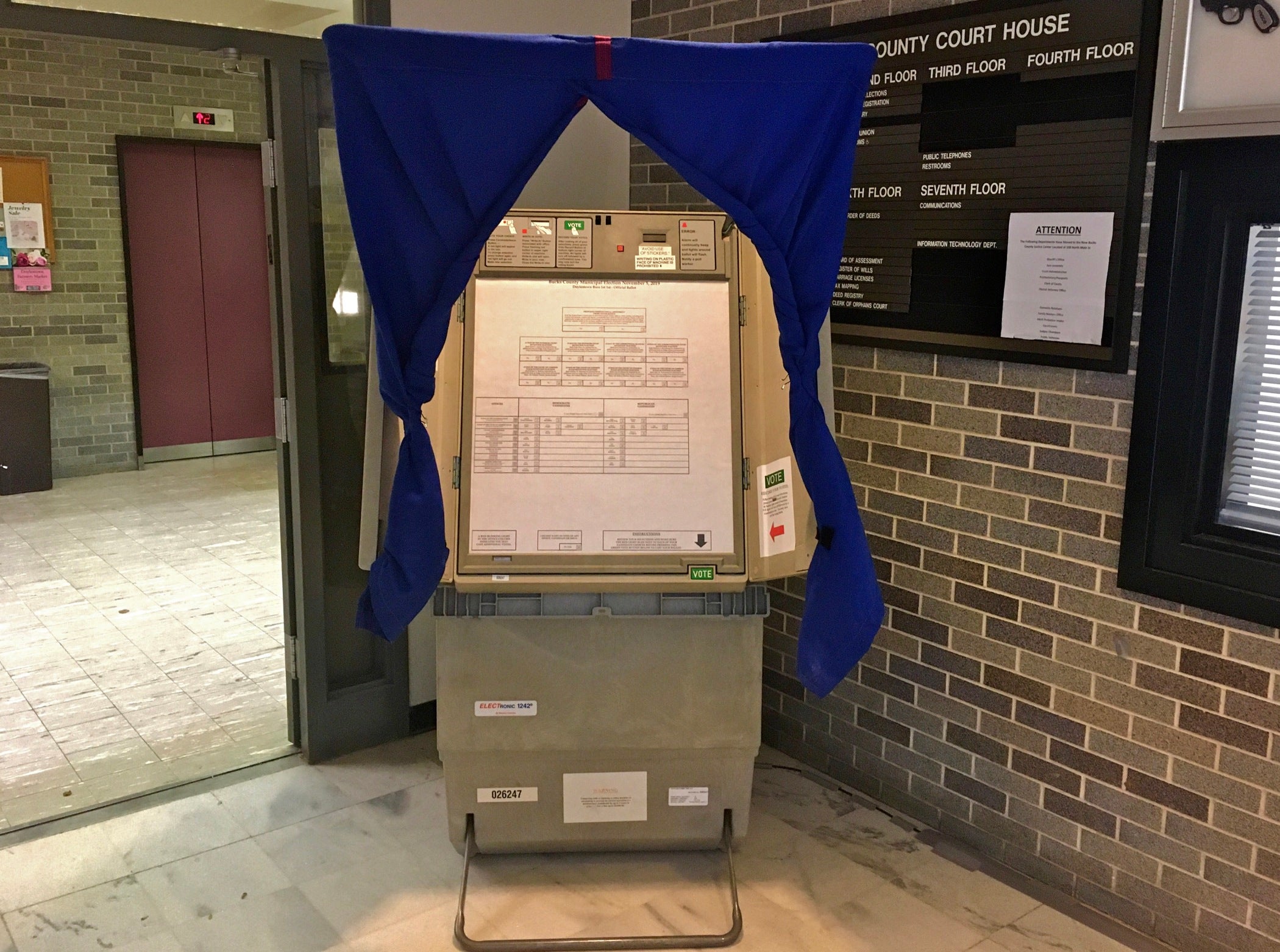
“We’re doing our due diligence to the greatest extent possible to make sure that the decision that we are selecting as a county is the best for a county of our size,” Giorno said. “We’re still researching a number of options.”
Because Bucks hasn’t selected which machines it will use next year, it doesn’t have an implementation plan yet for how it will spread the word about the new technology. But Giorno said the county will hold public demonstrations and plans to reach out to local committees and voter groups.
For Tuesday, though, voters don’t have to worry about learning anything new.
“It’s the same machine,” said Thomas Frietag, acting director of the Bucks County Board of Elections. “It’s not going to be anything new that they’re unfamiliar with this time.”
Delaware County
Voters here will also be using the same machine Tuesday that they’ve used in past elections, so they don’t have to prepare for anything new or different until next year.
Like Bucks County, Delaware County uses the Danaher 1242.
Last week, the Delaware County Council voted to purchase new machines from Hart Intercivic. Those machines, which cost the county about $6 million, will start being delivered in December, and the county will provide demonstrations and educational outreach materials to get voters up to speed before the April primary.
WHYY is your source for fact-based, in-depth journalism and information. As a nonprofit organization, we rely on financial support from readers like you. Please give today.



